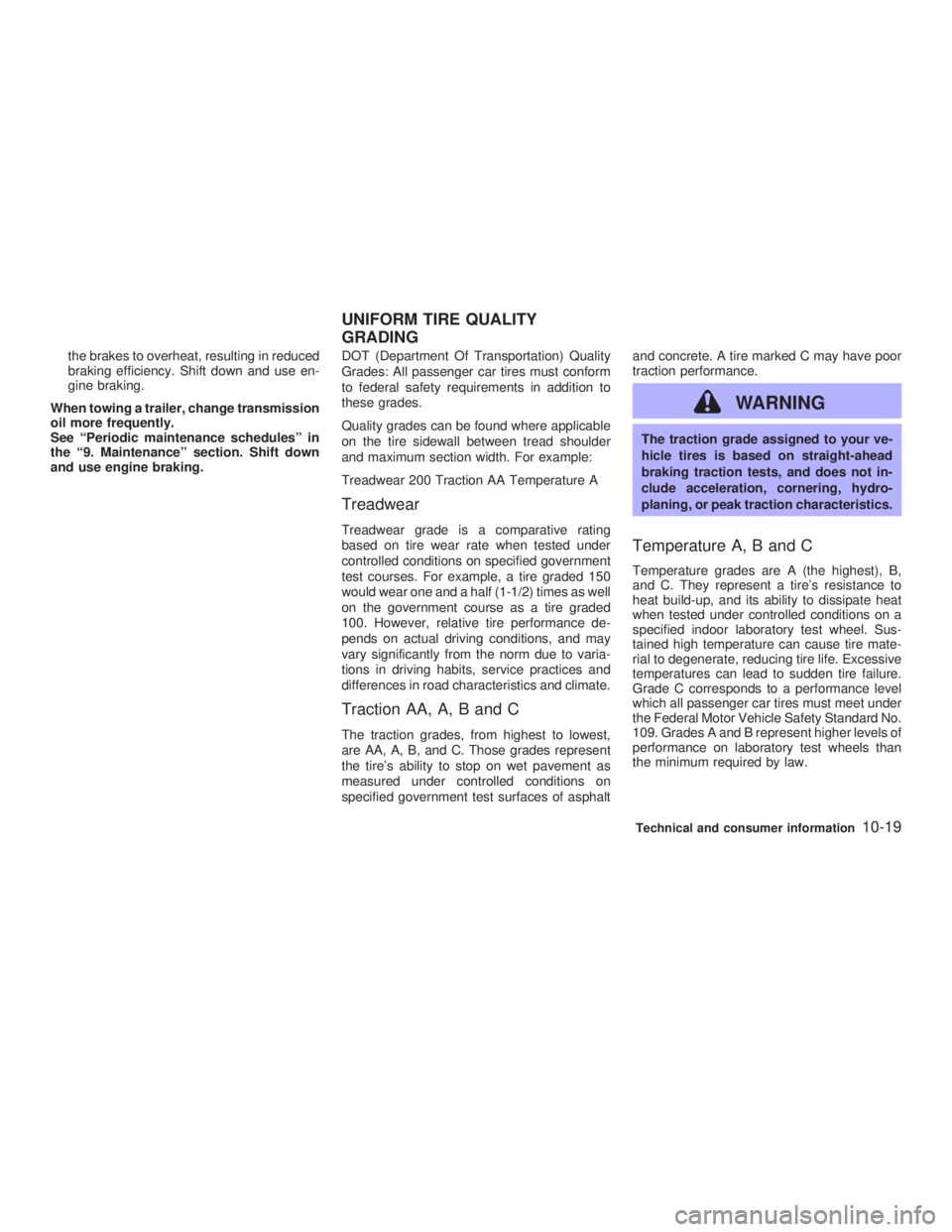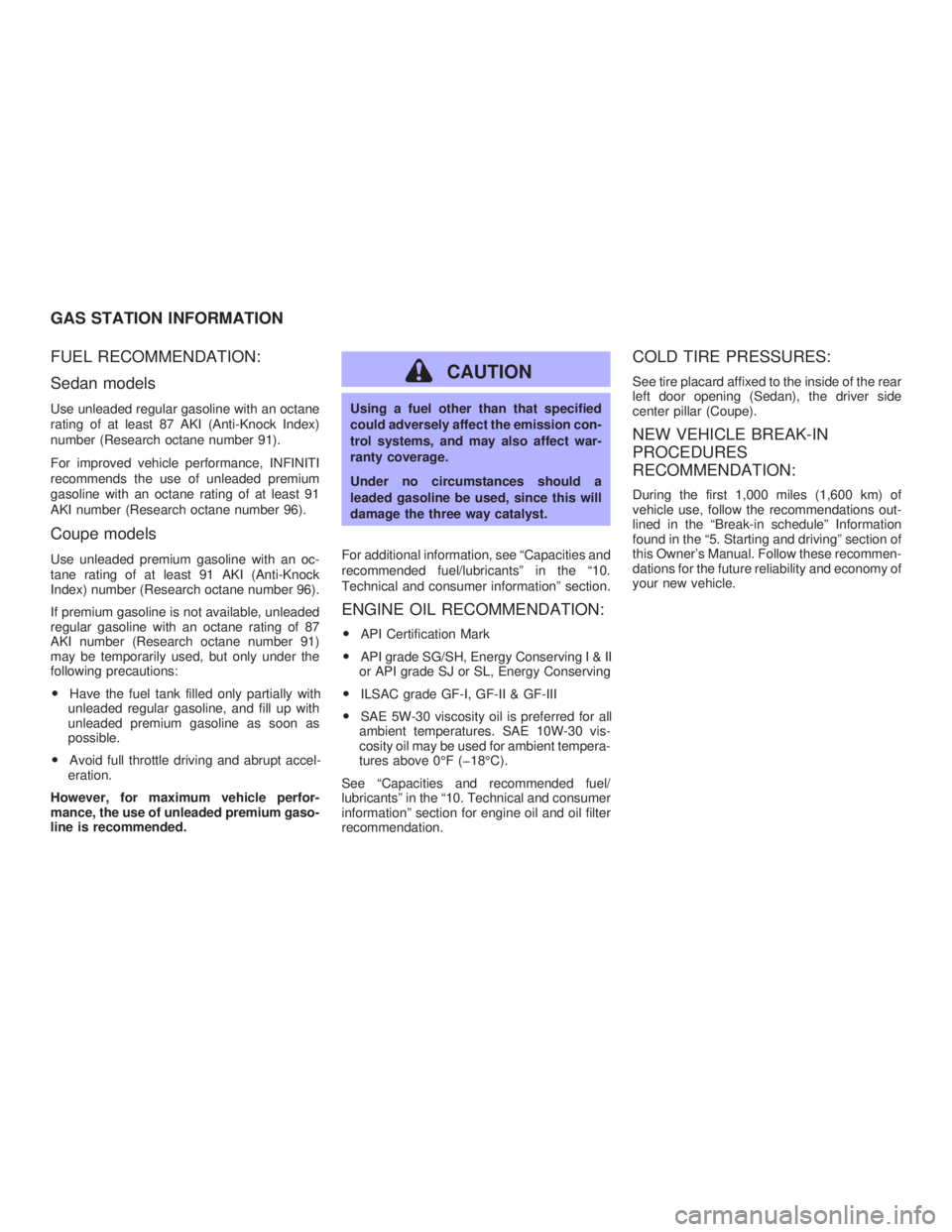2003 INFINITI G35 oil temperature
[x] Cancel search: oil temperaturePage 241 of 256

the brakes to overheat, resulting in reduced
braking efficiency. Shift down and use en-
gine braking.
When towing a trailer, change transmission
oil more frequently.
See ªPeriodic maintenance schedulesº in
the ª9. Maintenanceº section. Shift down
and use engine braking. DOT (Department Of Transportation) Quality
Grades: All passenger car tires must conform
to federal safety requirements in addition to
these grades.
Quality grades can be found where applicable
on the tire sidewall between tread shoulder
and maximum section width. For example:
Treadwear 200 Traction AA Temperature A
Treadwear Treadwear grade is a comparative rating
based on tire wear rate when tested under
controlled conditions on specified government
test courses. For example, a tire graded 150
would wear one and a half (1-1/2) times as well
on the government course as a tire graded
100. However, relative tire performance de-
pends on actual driving conditions, and may
vary significantly from the norm due to varia-
tions in driving habits, service practices and
differences in road characteristics and climate.
Traction AA, A, B and C The traction grades, from highest to lowest,
are AA, A, B, and C. Those grades represent
the tire's ability to stop on wet pavement as
measured under controlled conditions on
specified government test surfaces of asphalt and concrete. A tire marked C may have poor
traction performance.
WARNING The traction grade assigned to your ve-
hicle tires is based on straight-ahead
braking traction tests, and does not in-
clude acceleration, cornering, hydro-
planing, or peak traction characteristics.
Temperature A, B and C Temperature grades are A (the highest), B,
and C. They represent a tire's resistance to
heat build-up, and its ability to dissipate heat
when tested under controlled conditions on a
specified indoor laboratory test wheel. Sus-
tained high temperature can cause tire mate-
rial to degenerate, reducing tire life. Excessive
temperatures can lead to sudden tire failure.
Grade C corresponds to a performance level
which all passenger car tires must meet under
the Federal Motor Vehicle Safety Standard No.
109. Grades A and B represent higher levels of
performance on laboratory test wheels than
the minimum required by law.UNIFORM TIRE QUALITY
GRADING
Technical and consumer information
10-19
Z 02.7.29/V35-D/V5.0
X
Page 248 of 256

Installation on rear seat outboard or center
positions .................................................... 1-35
Precautions on child restraints .................. 1-33
Top tether strap anchor point locations .... 1-42
With top tether strap.................................. 1-41
Child safety ..................................................... 1-27
Child safety rear door lock................................ 3-5
Chimes, Audible reminders............................. 2-13
Cigarette lighter and ashtray .......................... 2-24
Circuit breaker, Fusible link ............................ 8-20
Cleaning exterior and interior .................... 7-2, 7-3
Clock ............................................................... 2-23
Clutch fluid ...................................................... 8-11
Coat fook (Coupe) .......................................... 2-30
Cold weather driving ....................................... 5-23
Compact Disc (CD) changer operation .......... 4-15
Compact spare tire ......................................... 8-34
Compass display .............................................. 2-6
Console box .................................................... 2-28
Controls
Heater and air conditioner controls
(automatic)................................................... 4-3
Steering audio control ............................... 4-17
Coolant
Capacities and recommended fuel/lubricants/
fluids .......................................................... 10-2
Changing engine coolant ............................ 8-6
Checking engine coolant level .................... 8-5
Corrosion protection ......................................... 7-5
Cruise control.................................................. 5-15
Cup holder ...................................................... 2-26 D
Daytime running light system ......................... 2-19
Defroster switch, Rear window and outside mirror
defroster switch ............................................. 2-16
Dehumidified defrosting or defogging ............... 4-4
Dimensions and weights ................................. 10-8
Door open warning light ................................. 2-10
Drive belts ....................................................... 8-14
Drive positioner, Automatic ............................. 3-19
Driving
Cold weather driving ................................. 5-23
Driving with automatic transmission .... 5-4, 5-8
Driving with manual transmission ...... 5-5, 5-12
Precautions when starting and driving ........ 5-2
E
Economy, Fuel ................................................ 5-17
Emission control information label ................ 10-11
Emission control system warranty ................ 10-20
Engine
Before starting the engine ........................... 5-7
Capacities and recommended fuel/lubricants/
fluids .......................................................... 10-2
Changing engine coolant ............................ 8-6
Changing engine oil and filter ..................... 8-8
Checking engine coolant level .................... 8-5
Checking engine oil level ............................ 8-7
Coolant temperature gauge ........................ 2-5
Engine block heater .................................. 5-24
Engine compartment check locations ......... 8-4
Engine cooling system ................................ 8-5 Engine oil..................................................... 8-7
Engine oil and oil filter recommendation... 10-5
Engine oil viscosity .................................... 10-5
Engine serial number .............................. 10-10
Engine specifications................................. 10-7
If your vehicle overheats ........................... 6-10
Starting the engine ...................................... 5-7
Exhaust gas (Carbon monoxide) ...................... 5-2
F
F.M.V.S.S. certification label......................... 10-10
Filter, Air cleaner housing filter ....................... 8-16
Flashers (See hazard warning flasher
switch) ............................................................. 2-20
Flat tire .............................................................. 6-2
Floor mat cleaning ............................................ 7-4
Fluid
Automatic transmission fluid (ATF) ............. 8-9
Brake and clutch fluid................................ 8-11
Brake fluid ................................................. 8-11
Capacities and recommended fuel/lubricants/
fluids .......................................................... 10-2
Engine coolant............................................. 8-5
Engine oil..................................................... 8-7
Power steering fluid................................... 8-10
Window washer fluid ................................. 8-12
FM-AM-satellite radio with cassette player and
Compact Disc (CD) changer........................... 4-11
Fog light switch ............................................... 2-20
Front air bag system (See supplemental restraint
system) ........................................................... 1-17
Front manual seat adjustment .......................... 1-2
Front power seat adjustment ............................ 1-4
11-2
Z 02.7.29/V35-D/V5.0
X
Page 255 of 256

FUEL RECOMMENDATION:
Sedan models Use unleaded regular gasoline with an octane
rating of at least 87 AKI (Anti-Knock Index)
number (Research octane number 91).
For improved vehicle performance, INFINITI
recommends the use of unleaded premium
gasoline with an octane rating of at least 91
AKI number (Research octane number 96).
Coupe models Use unleaded premium gasoline with an oc-
tane rating of at least 91 AKI (Anti-Knock
Index) number (Research octane number 96).
If premium gasoline is not available, unleaded
regular gasoline with an octane rating of 87
AKI number (Research octane number 91)
may be temporarily used, but only under the
following precautions:
O Have the fuel tank filled only partially with
unleaded regular gasoline, and fill up with
unleaded premium gasoline as soon as
possible.
O Avoid full throttle driving and abrupt accel-
eration.
However, for maximum vehicle perfor-
mance, the use of unleaded premium gaso-
line is recommended. CAUTION Using a fuel other than that specified
could adversely affect the emission con-
trol systems, and may also affect war-
ranty coverage.
Under no circumstances should a
leaded gasoline be used, since this will
damage the three way catalyst.
For additional information, see ªCapacities and
recommended fuel/lubricantsº in the ª10.
Technical and consumer informationº section.
ENGINE OIL RECOMMENDATION: O API Certification Mark
O API grade SG/SH, Energy Conservin gI&II
or API grade SJ or SL, Energy Conserving
O ILSAC grade GF-I, GF-II & GF-III
O SAE 5W-30 viscosity oil is preferred for all
ambient temperatures. SAE 10W-30 vis-
cosity oil may be used for ambient tempera-
tures above 0ÉF (þ18ÉC).
See ªCapacities and recommended fuel/
lubricantsº in the ª10. Technical and consumer
informationº section for engine oil and oil filter
recommendation. COLD TIRE PRESSURES: See tire placard affixed to the inside of the rear
left door opening (Sedan), the driver side
center pillar (Coupe).
NEW VEHICLE BREAK-IN
PROCEDURES
RECOMMENDATION: During the first 1,000 miles (1,600 km) of
vehicle use, follow the recommendations out-
lined in the ªBreak-in scheduleº Information
found in the ª5. Starting and drivingº section of
this Owner's Manual. Follow these recommen-
dations for the future reliability and economy of
your new vehicle.GAS STATION INFORMATION
Z 02.7.29/V35-D/V5.0
X